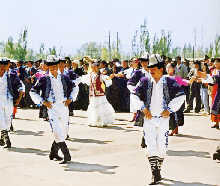Yunnan Volume: Peacock Dance of the Dai people
Peacock dance is mostly performed at the New Year (Water-splashing Festival) of the Dai's Clendar, "Gate Closing Festival", "Gate Opening Festival" and some important religious activities. It is one of the widely spread ancient dances of the Dai ethnic group of Yunnan Province and regarded as a symbol of good luck, so to perform this Peacock Dance is to present a eulogy of and express good wishes for a happy life.
Hainan Volume: Dachai (Cutting Firewood) Dance of the Li Ethnic Group
Cutting Firewood Dance is also called "Jumping over Bamboo Poles" and widely popular in the congregating area of the Li ethnic group of Hainna Province. The bamboo pole holders move these poles in different directions just to examine the flexibility and nimbleness of the jumpers. This dance is fairly interesting and quite popular with the local people.
 In the branch of the Li ethnic group, Xiao, there is a tradition of performing this dance at funerals with the belief that the living people are in one world while the dead in another. So, when somebody is dead, the living ones should happily see him off to the new world by performing this dance.
In the branch of the Li ethnic group, Xiao, there is a tradition of performing this dance at funerals with the belief that the living people are in one world while the dead in another. So, when somebody is dead, the living ones should happily see him off to the new world by performing this dance.
Guizhou Volume: Xianggao (Striking Bamboo Pole) Dance of the Buy!
Ethnic GroupStriking Bamboo Pole Dance is named after the sound the Buyi people produce while striking the broken long bamboo poles as its dancing props and popular in some villages and towns of Dushan County inGuizhou Province.
 On the occasions of festivals, weddings, funerals, or singing contests and sacrifices, Buyi people gather, perform this dance for entertainment with the beating of the copper drums and leather drums, and pray to god for peace and good health and express their great joy.
On the occasions of festivals, weddings, funerals, or singing contests and sacrifices, Buyi people gather, perform this dance for entertainment with the beating of the copper drums and leather drums, and pray to god for peace and good health and express their great joy.
Striking Bamboo Pole Dance is usually performed by young and mid-aged men and their movements are mainly characterized by swaying their waists left and right, striking the poles in their hands and changing the momentum and the speed of the drumbeats in order to coordinate with the movements and feelings of the dancers, thus producing a spell of ever changing stresses.
Guizhou Volume: Tiaoyue (Dancing to the Moon) of the Miao Ethnic Group
 Dancing to the Moon is a dance of the Miao ethnic group in Changtianxiang and Baijinzhen of Huishui County in Guizhou Province for sociality and choosing spouses. From the third to the thirteenth night of every first lunar month every year, people are dressed up beautifully in a festival type and gather on the spacious ground to do this dance with the number of dancing people from several dozen to over one thousand. Each dancing team is led by a young man who blows lusheng (a reed-pipe wind instrument) and is followed by female dancers.
Dancing to the Moon is a dance of the Miao ethnic group in Changtianxiang and Baijinzhen of Huishui County in Guizhou Province for sociality and choosing spouses. From the third to the thirteenth night of every first lunar month every year, people are dressed up beautifully in a festival type and gather on the spacious ground to do this dance with the number of dancing people from several dozen to over one thousand. Each dancing team is led by a young man who blows lusheng (a reed-pipe wind instrument) and is followed by female dancers.
In performing this dance, the male dancer in rich and constantly changing movements with his torso swinging to his own paces while his legs respectively half-squatting and sidewise stretching which twist the torso naturally. The females dance with handkerchiefs swinging in theirhands, dresses swinging, and silver decorations on their dresses ringing, which display the special charm of women of the Miao ethnic group.
XinjiangVolume: Kalajiaoleha (Black Walking horse) of the Hazak Ethnic Group
 Kalajiaoleha is the most representative folk dance in the daily life of the Hazak ethnic group and widely popular in the congregated residences of the Hazak people in Xinjiang Uygur Autonomous Region.
Kalajiaoleha is the most representative folk dance in the daily life of the Hazak ethnic group and widely popular in the congregated residences of the Hazak people in Xinjiang Uygur Autonomous Region.
Kalajiaoleha means a "black walking horse" in the Hazak language. As a Hazak ancient proverb goes: " Song and horse are the two wings of the Hazak people."
The male dancer's movements are brisk and forceful in an unrestrained and humorous manner while the female is graceful and elegant and lively, and her dance well combines her inner feelings and facial expressions.
